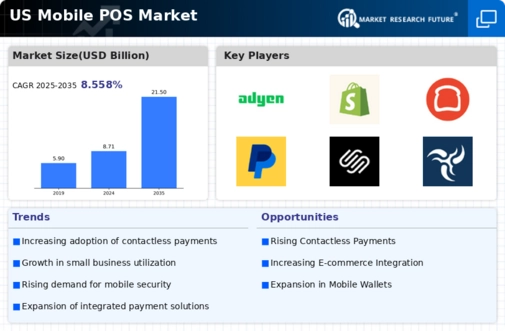Increasing Demand for Mobile Payment Solutions
The market is experiencing a notable surge in demand as consumers increasingly prefer mobile payment solutions. This shift is driven by the convenience and speed offered by mobile transactions, which are often perceived as more efficient than traditional payment methods. According to recent data, mobile payment transactions in the US are projected to reach approximately $1 trillion by 2025, indicating a robust growth trajectory. This trend is further fueled by the proliferation of smartphones and mobile applications, which facilitate seamless payment experiences. As businesses adapt to consumer preferences, the mobile pos market is likely to expand, providing innovative solutions that cater to the evolving needs of both merchants and customers.
Regulatory Support for Digital Payment Solutions
Regulatory support for digital payment solutions is emerging as a key driver for the mobile pos market. Government initiatives aimed at promoting cashless transactions and enhancing financial inclusion are encouraging businesses to adopt mobile payment technologies. For instance, various states have implemented policies that incentivize the use of digital payment systems, thereby fostering a conducive environment for the growth of the mobile pos market. Additionally, regulatory bodies are working to establish standards that ensure the security and interoperability of mobile payment solutions, which may further bolster consumer confidence. As these supportive measures continue to evolve, the mobile pos market is likely to benefit from increased adoption and innovation.
Technological Advancements in Payment Processing
Technological advancements play a pivotal role in shaping the mobile pos market. Innovations such as near-field communication (NFC), biometric authentication, and artificial intelligence are enhancing the functionality and security of mobile payment systems. These technologies not only streamline transaction processes but also improve customer experiences by reducing wait times and increasing transaction accuracy. The integration of advanced analytics into mobile pos systems allows businesses to gain insights into consumer behavior, enabling them to tailor their offerings effectively. As these technologies continue to evolve, the mobile pos market is expected to witness significant growth, with businesses increasingly adopting sophisticated solutions to stay competitive.
Shift Towards E-commerce and Omnichannel Retailing
The market is significantly influenced by the ongoing shift towards e-commerce and omnichannel retailing. As consumers increasingly engage in online shopping, businesses are compelled to adopt mobile pos solutions that facilitate seamless transactions across various channels. This trend is particularly evident in the retail sector, where companies are integrating mobile payment options to enhance customer convenience and satisfaction. Data suggests that omnichannel customers tend to spend 10-15% more than single-channel customers, highlighting the potential for increased revenue through mobile pos adoption. Consequently, the mobile pos market is likely to expand as retailers seek to create cohesive shopping experiences that bridge online and offline interactions.
Rising Consumer Preference for Contactless Transactions
The market is witnessing a rising consumer preference for contactless transactions, which are perceived as safer and more hygienic. This trend is particularly relevant in the context of retail and hospitality sectors, where speed and convenience are paramount. Data indicates that approximately 70% of consumers in the US express a preference for contactless payment methods, reflecting a significant shift in consumer behavior. This growing inclination towards contactless solutions is prompting businesses to invest in mobile pos systems that support such transactions. As consumer expectations evolve, the mobile pos market is likely to adapt, offering innovative solutions that prioritize convenience and safety in payment processing.

















Leave a Comment